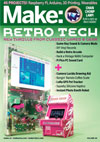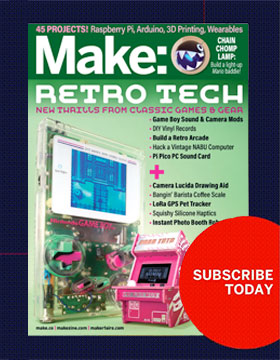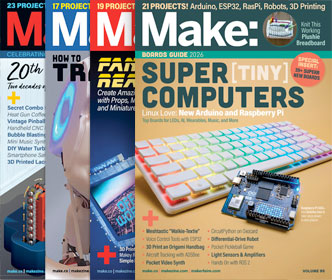
Howdy folks! Would you like to learn how to MAKE a maker class at your school? I have been a middle school art teacher for seven years and I want to share with you how I got my Project Make class up and running on a shoestring budget, with a large (35) group of low-income English Language learners. I mention this at the get-go, because NONE of my students had ever heard of the maker movement, let alone, gone to Maker Faire. Recycling, repurposing, and re-using things was not something they were excited about, at first. As one student put it, when I was encouraging them to bring in items like tin soup-cans, “so you’re telling us to bring in garbage? That’s gross.”
I took my class into the computer lab, and we browsed through Instructables to find some projects which used repurposed materials, and a few days later, they started bringing in tin cans, so I got out the clamps, nails and hammers, and we made these classic little lanterns. The exciting part was getting to go into the supply closet to “test them out” with some tiny tea candles.
Overcoming the cultural mores against re-use was just one of the challenges I experienced when launching my maker class. Another big area of concern for me was how to develop the interdisciplinary curriculum I would need to truly offer a S.T.E.A.M. class to my 7th and 8th graders. I have public, private, and Waldorf school teaching experience, but this exciting curriculum development is a new playing field for me, and I often have to limit the subject areas in order to just move ahead with a lesson or project.
A lot of folks ask where I get the tools, space, and consumables for my maker classes, so I want to explain where I began. A month before my Project Make class was launched, last year, I sent out letters on school letterhead, with our tax I.D. number included, to local businesses, and non-profits, asking for specific donations. For example, Safeway gave us a $25 gift card, with which I bought salt, sugar, flour, and food coloring so we could make conductive and non-conductive dough for Squishy Circuits. Our local Community Bikes non-profit gave us 10 “fixer-upper” bikes and parts, etc. One local hardware store gave me a gift card, and I picked up a class set of mason jars, for fermentation, nails, screws and sandpaper. I found that when you are clear about what you want, most folks, who can, will give it to you.
I happen to have a very supportive principal, who was able to dig up curriculum and instruction funds for me to purchase hammers, saws, clamps, a cordless drill, LED lights, rechargeable batteries, little solar panels with motors, and other necessary consumables for the class to be able to explore basic Making activities.
Next, I sent out emails to colleagues, friends, and parents, listing the materials we were looking for that were fairly common: string, tape, yarn, newspapers, magazines, recyclables, office supplies, old tools, clothing, fabric, computers, appliances, electronics, wood, pvc, or whatever they had lying around and thought we could use. Things arrived in boxes and piles, and I started to hoard them. When the piles threatened to overwhelm my classroom, the maintenance gentleman at my school helped me to get into, and then take over, an old shipping container that was sitting on the school grounds.
In addition to the 10+ bikes we received, I got a lot of left-over bike tubing that we made into bracelets and shoes. The guys at a nearby bike shop saved them for me when changing tires, and also let me take them out of the dumpster.
The bikes were fixed up during make class, and then raffled off to students who wrote descriptions of why they needed a bicycle to use. Fifteen helmets were donated by the local Helmet Bank, via my Safe Routes To School connection.
Here are some of our budding bike mechanics:
Classroom support is key to managing hands-on projects, and without my trusty maker volunteer, we would not have been able to do all the fantastic boat-building we were able to do last year. It is next to impossible to get the parents at my school to volunteer, so I got a friend, who was between jobs, but had a lot of construction experience to sign up for a two-week stint.
Check with your local volunteer center to see if you can get someone with basic experience into your classroom to help the students learn to use the tools and materials. We put up caution tape, to cordon off a large area in the classroom, and he led small groups of students in building boats out of repurposed 50 gallon barrels, 2×4’s, plywood, and other basic materials. When we had completed four or five boats, we took them out to a nearby lake, and the students raced them. We called the event “Trashtastic Boatacular,” and it was a LOT of work, but an amazing experience for all of us. There is a nice article about it here.
In my school district, Common Core is being implemented, and it is opening up new opportunities to integrate the arts and making, into the “core” curriculum, and to build community within my school. This semester, the science department brought in the County Water Agency to give the students presentations about our local watersheds. In English classes, they will be writing short stories based on the creatures who live in our watershed, and in maker class we will be designing and illustrating the small books that we will submit to the Water Agency’s annual competition.
This week we have been building planter boxes, in teams of four, with donated two-foot pieces of redwood. We suffered a few splinters, one blood blister, lots of bent nails, and several holes accidentally drilled into our tables, but most of the students were very excited about the project. We discovered that one girl, in particular, had learned awesome building skills “from my dad,” and she helped her team, and others to build some amazing boxes. Here she is showing the other girls how to use a hammer.
One of the great things about teaching Project Make at the middle school level, is that a lot of girls are not afraid to pick up the drill, or to lead an electronic circuit-building lab. These hands-on challenges seem equally appealing to both genders in my classroom.
In closing, I want to share my favorite thing about make class, so far, and it is this:
When given the chance, students will self-select into co-operative learning teams with clearly defined, yet evolving roles. The teams naturally work together to problem-solve and to meet challenges, all within an undefined set of parameters. It is amazing to watch, even when there is bickering, and it demonstrates an innate, group human intelligence that gives me a lot of hope for our future on the planet. Let’s build more make classes!
4 thoughts on “How to Make a Maker Class”
Comments are closed.
ADVERTISEMENT
Join Make: Community Today










Nice post, a lot of ideas to work with. Always it is rewarding to work with children, we do so.
http://albertomorales.eu/technical-workshop-for-kids-in-madrid-an-introduction-to-electricity-electronics-and-robotics-2nd-wee/
Regards. Alberto Morales.
Thanks Alberto! Do you do the projects in your blog with middle-school students? I have wondered about doing Arduino with my students, but thought it might be above their ability.
Dawn